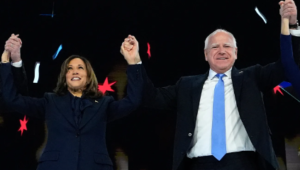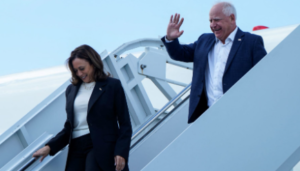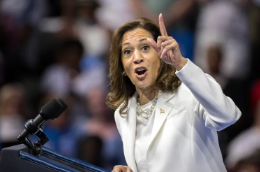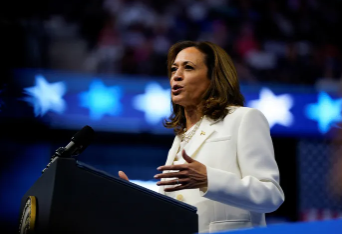Kamala Harris and Tim Walz sat down with CNN’s Dana Bash in their first in-depth interview since launching their bid for the White House, offering insights into their campaign priorities and strategies.
1. Kamala Harris Prioritizes Middle-Class Support
In her first major TV interview, Democratic presidential nominee Kamala Harris outlined her top priority if elected: bolstering the middle class. Speaking with CNN’s Dana Bash, Harris emphasized policies such as a child tax credit, lowering grocery costs, and increasing housing construction to address nationwide shortages. Harris also drew a stark contrast with her Republican rival, former President Donald Trump, promising a presidency focused on unity and problem-solving.
2. Harris Open to Appointing a Republican to Her Cabinet
In a move highlighting her commitment to diverse perspectives, Harris revealed she would consider appointing a Republican to her Cabinet. “It’s important to have people at the table with different views and experiences,” Harris said, signaling her willingness to break from partisan norms. The last president to include a member of the opposing party in the Cabinet was Barack Obama, making Harris’s potential appointment a notable departure from recent administrations.
3. Addressing Policy Reversals: Harris Defends Her Shift
During the interview, Harris faced questions about her shift in policy stances since her 2020 presidential campaign. Notably, she has backed away from supporting Medicare for All and banning fracking, two positions she previously championed. Harris explained that her core values remain unchanged but that her approach has evolved to balance economic growth with environmental protection. This pragmatic stance aims to appeal to voters in key battleground states like Pennsylvania and Ohio.

4. Inside Joe Biden’s Decision to Withdraw
Harris shared a personal moment when she learned of President Joe Biden’s decision to withdraw from the 2024 presidential race. Recounting the day, Harris described receiving the news from Biden while spending time with her family. Despite his withdrawal, Harris praised Biden’s presidency, calling it “transformative” and contrasting his leadership qualities with those of Trump.
5. Harris’s Stance on Gaza: A Balancing Act
As the interview wrapped up, Bash questioned Harris on her stance regarding Israel’s actions in Gaza. Harris reaffirmed her “unequivocal and unwavering” support for Israel’s right to defend itself but acknowledged the tragic civilian casualties in Gaza. She expressed a desire for a ceasefire, reflecting a balanced approach that may appeal to both pro-Israel and progressive voters.
Kamala Harris’s first major TV interview as a presidential candidate highlighted her campaign’s central themes: support for the middle class, a willingness to embrace diverse perspectives, and a pragmatic approach to policy. As the election nears, these insights offer a glimpse into how Harris and Walz plan to position themselves against their Republican opponents.
Polling Data
Recent Polling Trends: Include recent polling data showing Harris’s position relative to Donald Trump, especially in key battleground states like Georgia, Pennsylvania, and Ohio. For example, you could mention that a recent Reuters/Ipsos poll shows Harris leading Trump by 4 points nationally, with 45% to his 41%.
Voter Demographics
Voter Demographic Insights: Provide details on how Harris’s policies and campaign strategies are resonating with different voter demographics. For example, you could mention her strong support among African American voters, women, and young voters, and discuss how her stance on issues like fracking and the middle class might appeal to suburban voters.
Campaign Strategy
Campaign Strategy and Stops: Add information about Harris’s campaign stops in key states, like Georgia, which she has prioritized due to its battleground status. Discuss her strategy of focusing on swing states, and how that aligns with her broader campaign goals.
Economic Impact of Proposed Policies
Economic Impact Projections: Include data or expert opinions on the potential economic impact of Harris’s proposed policies, like the child tax credit or housing initiatives. This could involve citing studies or economic models that project the benefits of these policies for the middle class.
Historical Context
Historical Comparisons: Compare Harris’s approach to that of previous candidates or administrations. For instance, discuss how her openness to appointing a Republican to her Cabinet is reminiscent of President Obama’s bipartisan efforts, and how this might appeal to moderate voters.

Criticism and Challenges
Criticism from Opponents: Include critiques from political opponents or analysts who might question Harris’s shifts in policy or her ability to unite a divided country. This could involve citing statements from the Trump campaign or Republican leaders.
International Implications
Foreign Policy Considerations: Expand on Harris’s stance on Gaza by discussing the broader implications of her foreign policy positions. How might her approach differ from Biden’s or Trump’s? What are the potential impacts on U.S. relations in the Middle East?
Voter Sentiment and Engagement
Voter Sentiment: Provide data on voter enthusiasm or concerns. For example, you could mention how Harris’s campaign is performing in terms of fundraising, volunteer engagement, and voter outreach efforts, especially in comparison to the Trump campaign.
Expert Opinions
Analysis from Political Experts: Incorporate quotes or analysis from political scientists, campaign strategists, or historians who can provide insight into Harris’s campaign strategies, her policy shifts, and the potential challenges she faces.
Visuals and Infographics
Infographics: Create or describe potential infographics that could accompany the article, such as charts showing polling trends, maps of campaign stops, or breakdowns of voter demographics.
Including these elements will create a more comprehensive and data-rich article, appealing to readers looking for in-depth analysis of Kamala Harris and Tim Walz’s first major TV interview and their campaign strategies.






